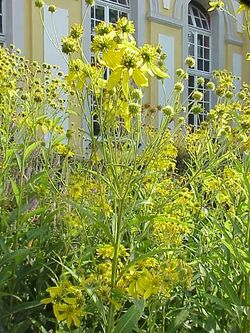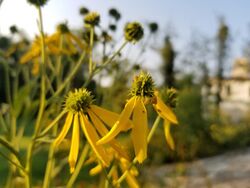Biology:Verbesina alternifolia
| Verbesina alternifolia | |
|---|---|

| |
| Wingstem in cultivation | |
| Scientific classification | |
| Kingdom: | Plantae |
| Clade: | Tracheophytes |
| Clade: | Angiosperms |
| Clade: | Eudicots |
| Clade: | Asterids |
| Order: | Asterales |
| Family: | Asteraceae |
| Genus: | Verbesina |
| Species: | V. alternifolia
|
| Binomial name | |
| Verbesina alternifolia Britton ex Kearney (L.)
| |
| Synonyms | |
| |
Verbesina alternifolia is a species of flowering plant in the family Asteraceae. It is commonly known as wingstem[2] or yellow ironweed.[3] It is native to North America.[2]
The name "wingstem" refers to the petioles of the leaves, which run down the stem and form raised ridges or "wings" along it.[4] The plant grows 3-8 feet tall with an unbranched stem until reaching the inflorescence at the very top.[5] Its yellow flower heads, which bloom in late summer through early fall, are 1-2 inches wide and consist of up to 10 bright yellow ray florets that are angled downward, each bearing a notch at the end, as well as a spherical cluster of tubular yellow disk florets in the center.[6]
Ecology
This plant grows in fertile, moist low-lying areas, such as near creeks and in open bottomland woods, usually not far from a body of water or woodland.[5][7] The tubular disk florets in the center of every flower head attract long-tongued bees such as bumblebees and butterflies, while being less attractive to shorter-tongued insects like wasps and flies.[5]
Verbesina alternifolia is sometimes considered weedy.[8] It thrives and competes well in both disturbed and less disturbed habitats, and often forms colonies by spreading vegetatively from rhizomes.
The seeds are attractive food for birds.[9] The foliage is not preferred food by deer and other herbivores.[5][10]
As host plant
It is a larval host to the gold moth (Basilodes pepita) and the silvery checkerspot (Chlosyne nycteis).[11]
References
- ↑ NatureServe (1 September 2023). "Verbesina alternifolia". Arlington, Virginia: NatureServe. https://explorer.natureserve.org/Taxon/ELEMENT_GLOBAL.2.159242/Verbesina_alternifolia.
- ↑ 2.0 2.1 "Verbesina alternifolia". Natural Resources Conservation Service PLANTS Database. USDA. https://plants.usda.gov/core/profile?symbol=VEAL. Retrieved 2018-04-07.
- ↑ "Verbesina alternifolia - Plant Finder". Missouri Botanical Garden. http://www.missouribotanicalgarden.org/PlantFinder/PlantFinderDetails.aspx?kempercode=a753.
- ↑ "Us Wildflower- Wingstem, Yellow Ironweed". https://uswildflowers.com/detail.php?SName=Verbesina%20alternifolia.
- ↑ 5.0 5.1 5.2 5.3 Hilty, John (2016). "Wingstem (Verbesina alternifolia)". http://www.illinoiswildflowers.info/savanna/plants/wingstem.htm.
- ↑ "Know Your Natives- Yellow wingstem". Arkansas Native Plant Society. 13 November 2015. https://anps.org/2015/11/13/know-your-natives-yellow-wingstem/.
- ↑ Carter, Richard; Morris, M. Wayne; Bryson, Charles T. (1990). "Some Rare or Otherwise Interesting Vascular Plants from the Delta Region of Mississippi". Castanea 55 (1): 43.
- ↑ "Verbesina alternifolia". https://www.missouribotanicalgarden.org/PlantFinder/PlantFinderDetails.aspx?kempercode=a753.
- ↑ "Verbesina alternifolia". https://www.missouribotanicalgarden.org/PlantFinder/PlantFinderDetails.aspx?kempercode=a753.
- ↑ "Know Your Natives- Yellow wingstem". Arkansas Native Plant Society. 13 November 2015. https://anps.org/2015/11/13/know-your-natives-yellow-wingstem/.
- ↑ The Xerces Society (2016), Gardening for Butterflies: How You Can Attract and Protect Beautiful, Beneficial Insects, Timber Press.
Wikidata ☰ Q11933237 entry
 |






